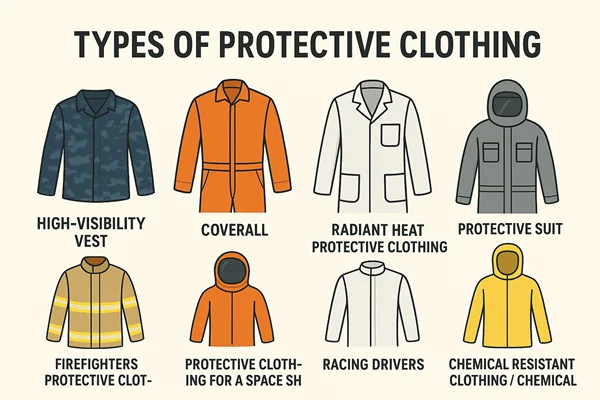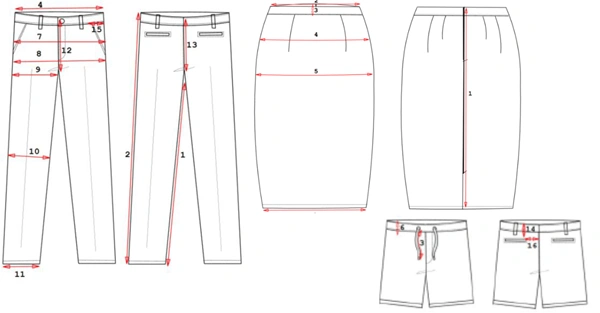Points of Measurement (POM) for Shirts & Pants in Garments
Points of Measurement (POM) for Shirts and Pants in Garments Manufacturing
Garments measurement is a very important factor for the garment industry because customers set measurement requirements as per human body shape. There is a product-wise measurement specification of every buyer, measurement upper and lower tolerance, also mentioned in the measurement spec. Measurement tolerance varies from product to product, buyer to buyer, based on fabrics, as the shrinkage test plays a key role here. There are so many factors that work behind the correct measurement. This article is about the Points of Measurement (POM) for Shirts and Pants in Garments Manufacturing.

Garment manufacturers have to ensure every point of measurement (POM) meets the specification and is measured 100 % in the Sewing and finishing stage in the garments industry. Any garment that is out of tolerance as per the spec should be rectified or scrapped. Buyer QC also checks measurement points in the final inspection. So the value of knowing the point of measurement (POM) is very high for every garment manufacturing-related professional. Knowing Points of Measurement (POM) for Shirts and Pants in Garments Manufacturing is important.
Points of Measurement (POM) for Shirts/ Polo Shirts/T-shirts
| Points of Measurement | POM Description |
| Neck | Banded Center Button to End of Button Hole |
| Chest | One inch below armhole |
| Waist | Narrowest Point |
| Sweep | Closed at bottom of the side seam |
| Front Length | Center, Base of Collar of Band to bottom hem |
| Side Seam | Armpit to Bottom Hem |
| Armhole | Shoulder top to armpit |
| Back Length | Center, base of collar or band to bottom hem |
| Shoulder Width | Sleeve set to Sleeve set at top |
| Long Sleeve Length | Center Back, Base of Collar or Band to end of Cuff or Slv |
| Short Sleeve Length | Sleeve Head to Edge |
| Cuff Length | At Widest Point |
| Short Sleeve Opening | Sleeve Circumference at hem |
| Cuff Length at Seam | Finish Edge to Finish Edge at Sleeve Join |
| Cuff Length at Edge | Finish Edge to Finish Edge at End of Cuff |
| Collar Point Length | Collar Base to End of Point |
| Collar Height | Collar band seam to edge at CB |
| Collar Band Width | Collar Seam to Body Seam at Center Back |
| Front Placket Width | Finish Edge to Finish Edge |
| Lower Placket Width | Finish Edge to Finish Edge |
| Pocket placement -HPS | From high point of the shoulder |
| Pocket placement – CF | From the center of placket to pocket |
Points of Measurement (POM) for Pants/ Trouser
| Points of Measurement | POM Description |
| Waist | Waist — relaxed method |
| Waist | Waist – Stretched measurement. |
| Outseam | Outseam to top of waistband |
| Bottom Hem | Width of the bottom hem |
| Hip/ Seat | Seat – straight across |
| Thigh | Thigh – 1″ down from the crotch |
| Knee | Knee @ midpoint of inseam |
| Front rise | Front rise |
| Back rise | Back rise |
| Inseam | Inseam |
| Fly | Fly size / zipper length |
| Fly | Fly width |
| Front pocket | Front pocket width |
| Front pocket | Front pocket length |
| Back pocket | Back pocket width |
| Back pocket | Back pocket length |
| Back Pocket | Back Pocket Position from Center Back |
| Back Rise Position | Back Rise Position From W/S at Center Back |
| Back Pocket Position | Back Pocket Position From WB to Side Seam |
| Yoke Height | Yoke Height at Side Seam |
| Bottom Hem | Bottom hem height |
| Cargo Pkt | Cargo Pocket Width |
| Cargo Pkt | Cargo Pocket Length |
| Flap | Flap Width |
| Flap | Flap Height |
Points of Measurement (POM) in Garments have to be extremely fitting in the garment industry on shirts and trousers for maintaining uniformity, quality, and correct fitting. With the standardization of activities such as chest width, sleeve length, shoulder width, waist circumference, inseam, and outseam, errors can be reduced by manufacturers, thereby minimizing material wastage and enhancing customer satisfaction.
- You may love to read: Measurement Control SOP of the Garments Industry.



